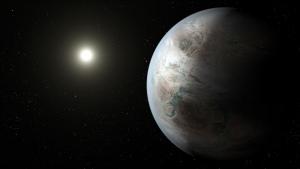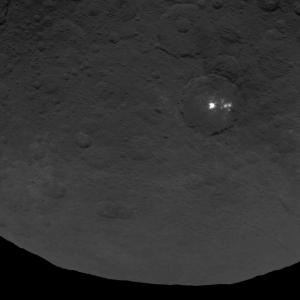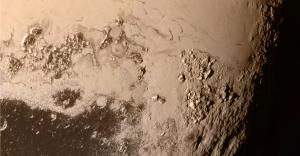
Public Stargazing
- Where:
- Frosty Drew Observatory
- When:
- Friday July 24, 2015 at 6:00 p.m.
- Cost:
- $1 Suggested Donation per Person
Tonight's forecast is calling for partly cloudy skies becoming clear. A brief jump in cloud cover in the mid afternoon, which may bring a t-storm or two, should progressively clear just after sunset. The 60% waxing gibbous Moon will be with us at sunset and will set around 12:30 a.m. leaving behind dark skies and the bright Milky Way. A slow starter night that could turn out awesome!
The Observatory and Sky Theatre will open at 6:00 p.m. tonight. Since clouds will block our view of the Sun, the Observatory will showcase the latest images of Pluto coming in from the New Horizons mission. Once the Sun sets, we will direct our telescopes towards Venus, which has waned to a stunning 14% crescent, Saturn, and the gibbous Moon. The Nature Center will be open from 7:00 p.m. - 10:00 p.m. with Naturalists on hand showcasing our daytime events. The Lunar Lounge, which is setup on the Northwest outer wall of the Sky Theatre, will feature a live projected view of the 60% gibbous Moon. Once the Moon sets, we will direct our telescopes towards the center of the galaxy and observe many fascinating nebulae and star clusters. In the Sky Theatre we will feature some of the astrophotos we capture at Frosty Drew with an open discussion on general astronomy.
Though tonight's forecast is starting off a bit slow, the skies should clear up in time for our celestial geek out. Saturn will be visible well into the night offering views to impress the most hardened astro-geeks. Check us out on Twitter (@FrostyDrewOBSY) and Facebook for updates from the Observatory. We may post updates on what we are observing, though most updates are related to inclement weather. If you don't see a post about clouds or standby, then it is likely clear enough for viewing on site. We post a closing up message when we decide to pack it in. Stop in tonight, check out Saturn, geek out a bit with us, and gear up for the Perseid Meteor Shower which started last week and is already offering a few sightings.
-------------------------------------------------------------------------
Weekly Happenings
Scott MacNeill
Yesterday, NASA announced that the first near-Earth-size planet in the habitable zone around a star that very closely resembles the Sun was found and confirmed. The habitable zone, is a region around a star where liquid water can exist on a planet's surface. The newly confirmed planet is designated Kepler-452b and is the smallest planet to date identified in the habitable zone around a Sun-like star. Kepler-452b is about 60% larger in diameter than Earth, orbits it's parent star every 385 days, has twice the gravity of Earth, and is about 6 billion years old (a bit older than Earth). Now this doesn't mean that we have a play-date with E.T., though this discovery is substantial and brings us another step along the way to finding another Earth.
This past week the NASA Dawn mission, which is currently orbiting dwarf planet Ceres, has commenced descent to its third mapping orbit. A five week maneuver that will bring Dawn within 900 miles of Ceres surface. At this new mapping orbit, Dawn will acquire mind blowing images of the dwarf planet's surface, which continues to thwart our investigations with its mysterious features. One of these mysterious features are the significant amount of white spots that are found all over the surface. These spots are similar to the rather large white spot that is the topic of much discussion about Ceres. Scientists are currently leaning towards salt or water ice being responsible for these highly reflective areas. Hints of potential haze or atmosphere forming over these white spots may point to the presence of liquid water on Ceres. Last year the ESA (European Space Agency) Hershel mission reported the presence of water vapor rising from Ceres surface. Could this water vapor be originating from these mysterious white spots on Ceres surface? Let's wait until we get a bit closer and have better observations before going there! Regardless, nothing short of awesome is happening in the Asteroid Belt! Keep up with the discoveries at NASA Photojournal Ceres
Pluto, yeah that crazy dwarf planet with a heart on its surface! Well we are about 1.5 weeks past the historic fly-by encounter that the NASA New Horizons mission performed and the images are slowly coming back. At this point we have many ideas and budding hypotheses about what is happening on Pluto and its moons, though the mysteries and questions keep getting bigger. We see a rather youthful surface on both Pluto and Charon (Pluto's largest moon). This offers clues into active or recent geological processes. We see icy mountains on the surface of Pluto, one range as large as the Rocky Mountains, with a second range to the west as lofty as the Appalachian Mountains. What was just points of light on the black background of space a week ago, is now the distinct shapes and features of Pluto's moons, Hydra and Nix. Both discovered in 2005 by the Hubble Space Telescope, Nix has a rather mysterious red region resembling a bulls-eye shape in recent images from New Horizons. As we patiently wait for additional information to arrive at planet Earth, anxiety mounts with an occasional freak-out breaking free. Tune in to the adventure at NASA New Horizons
Save the Date: Under the Perseids – The Perseid Meteor Shower at Frosty Drew Observatory. Wednesday, August 12, 2015.
-Scott



